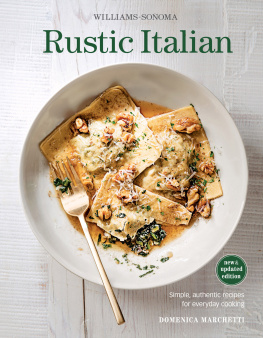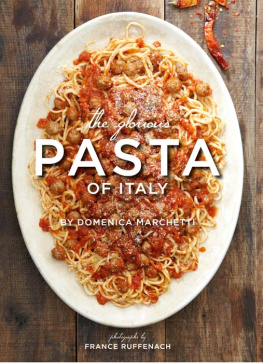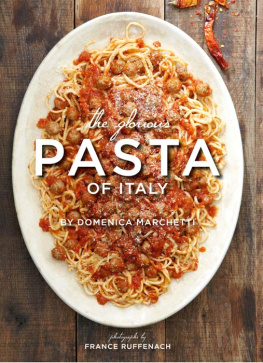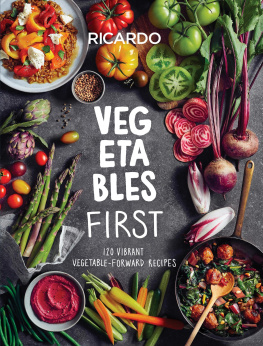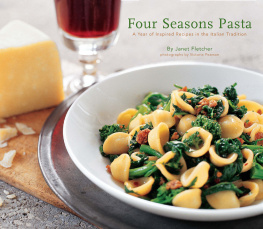
Text copyright 2013 by Domenica Marchetti.
Photographs copyright 2013 by Sang An.
All rights reserved. No part of this book may be reproduced in any form without written permission from the publisher.
ISBN 978-1-4521-2964-8
The Library of Congress has cataloged the print edition under ISBN 978-1-4521-0886-5.
Designed by Sara Schneider
Prop styling by Glenn Jenkins
Food styling by George Dolese
Assistant food styling by Elizabet Nederlanden
Typesetting by DC Type
Cynar is a registered trademark of Campari. Rogue Creamery
Smokey Blue is a registered trademark of Rogue Creamery.
Chronicle Books LLC
680 Second Street
San Francisco, California 94107
www.chroniclebooks.com

contents
ACKNOWLEDGMENTS
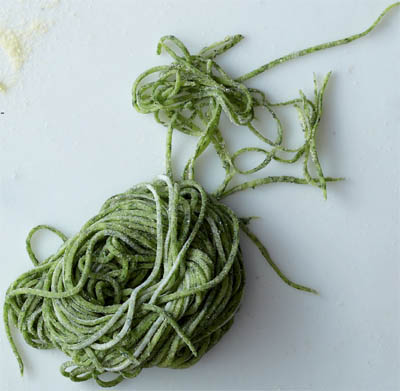
I have always been an enthusiastic consumer of vegetables, so writing (and cooking) this book has been a dream come true. Id like to thank those who helped in its creation:
To my editors at Chronicle Books, Bill LeBlond and Amy Treadwell, a heartfelt thanks for your enthusiastic support of my work, and for your patience and understanding while I dealt with a most untimely hand injury!
Thanks to my friend and agent, Lisa Ekus, and her excellent staff at the Lisa Ekus Group, for your expert advice and guidance through this project.
I would like to express my gratitude to designer Sara Schneider, who once again took several hundred pages of my words and transformed them into a beautiful book; and to photographer Sang An, whose stunning images present Italian vegetables in all the glory they deserve. Thank you also to George Dolese, Glenn Jenkins, and Elizabet Nederlanden.
At Chronicle Books, I would also like to thank Peter Perez and David Hawk, who always work so hard on my behalf. It is a pleasure to work with you. Shouts out also to production coordinator Tera Killip, and to Doug Ogan, Claire Fletcher, and Marie Oishi. And a big thanks to Ellen Wheat for your eagle-eye copyediting.
Seeds from Italy founder Bill McKay and current owner Dan Nagengast generously shared their knowledge of, and love for, Italian heirloom vegetables. Thank you for your dedication to spreading the word about these glorious Italian varieties and for making them accessible this side of the Atlantic. Of course, seeds need to be nurtured to grow into beautiful, edible vegetables. For this I thank farmers, from those who set up stalls every week in the parking lot of my local library in Virginia to those across the ocean who work the terraced hills of Italy and beyond. A special tip of the hat to Aubrey King of Twin Springs Fruit Farm, in Orrtanna, PA, whose candy-sweet buttercup squash inspired several recipes in this book, including the Winter Squash Panna Cotta .
Im grateful to the friends who generously shared their recipes, tips, expertise, and thoughtful advice, especially Amy Albert, Nancy Baggett, Cathy Barrow, Amy Brandwein, John Coletta, Marcello De Antoniis, Joe Gray, Diane Morgan, and Titti Pacchione. A special thanks to Olga Berman for her lovely authors photo.
Thanks also to the many friends who are always supportive and who continue to inspire me and keep me motivated, especially my American Food Roots team Bonny Wolf, Michele Kayal, and Carol Guensburg.
And finally, I am grateful to my family for always supporting me cento per cento: my parents, Gabriella and Frank; my sister, Maria; my niece, Gina; and my brother-in-law Tony; and my brothers-in-law Darren and John; and my nephew Xander; and to my cousins Coco and Cheryl. And most especially to Nick, Adriana, and Scott, who are sort of like the leafy green vegetables of my life. They nourish me every day.
INTRODUCTION
In 2008, my family and I took a trip to Venice. Five years later, my most vivid memory of that trip is not of the Piazza San Marco, or the cathedral, or the gondolas wending their way through the canals. It is of the incredible display of vegetables at the Rialto farmers market. The selection of radicchio alone was enough to make me dizzyfat, scarlet bouquets of Chioggia and Verona; furled red and white fingers of Treviso; pale green and pink-speckled heads of Castelfranco. Behind them spilled blood-red tomatoes and peppers, and atop those sat a big, squat winter squash, sliced in half, its orange flesh practically glowing. What a show!
In many ways, Italian cooking is really a celebration of vegetables. Think about all the vegetables that are featured prominently in Italian dishes: artichokes, asparagus, beansgreen and driedbroccoli, cauliflower, cabbage, carrots, chard, chicory, eggplant, kale, mushrooms, onions, peppers, potatoes, spinach, tomatoes, and more. The variety is breathtaking, and the ways in which these vegetables arrive at the table is even more so.
There is a practical reason for this, of course: Until fairly recently, meat was too costly to be served in large portions every day, but vegetables have always been plentiful. The Italian peninsula is blessed with a long growing seasonyear-round in some partsand the climate is reflected in the wealth of the vegetable harvest, from the many varieties of ruffled radicchio found in the Veneto region to the famed meaty San Marzano tomatoes of Campania.
Italian home cooks prepare these vegetables thoughtfullywith love, reallyintegrating them into seasonal soups and pastas, mixing them into nourishing frittatas and savory tarts, showcasing them on top of pizza, and giving them equal time with meat and seafood at , layered with eggplant, peppers, zucchini, and smoked scamorza cheese, is every bit as satisfying as a Sunday pork roast.
Of course, vegetables are also served in their purest form, fresh and at the height of their season, lightly cooked and dressed only with good olive oil. If you have ever sat down to eat at an Italian trattoria, you might recall the platters of vegetables set out on the communal table to entice dinerssilky grilled eggplant slices, glossy strips of roasted peppers, and whole baby artichokes anointed with olive oil.
It has always mystified me to see the contortions that so many American parents go through trying to get their kids to like vegetablesdousing them in ranch dressing, hiding them in baked goods, or falling back on fries. I honestly cant remember vegetables being an issue at our house when I was growing up. They were just always there. In fact, not always but very often, they were my favorite part of the meal.
Thanksgiving is a good example. Yes, we all looked forward to the turkey. But it was really the vegetable dishes that my mom prepared to go with the turkeysaucy, braised sweet-and-sour cabbage, garlicky rapini, sauted cauliflower punched up with anchovies and oil-cured olivesthat made the meal. (Incidentally, you will find these recipes within the pages of this book.)
In Italy, where I spent my summers, nearly every day began with a trip to a farmers market. My mother and her three sisters sniffed, prodded, poked, and haggled over the price of every vegetable that went into their sack. It is no surprise that my adult self adores most vegetables, and I would be hard-pressed to come up with one that I dont enjoy.
The good news is that those of us who love vegetables are no longer the exception in the United States. Farmers markets have sprung up everywhere over the last few decades, seducing cooks and consumers with their gorgeous vegetable offerings. Whats especially wonderful about this growing trend is that so many of the vegetables featured in these markets are the same vegetables that are at the heart of Italian cooking. Elegant long-stemmed fennel with creamy white bulbs; dark, bumpy leaves of Tuscan kale; scarlet radicchio; and delicate baby zucchini with yellow blossoms still attachedall of these were once hard to find but are now common at many farmers markets and some supermarkets. Even at the tiny farmers market that sets up in the parking lot of my local library every Wednesday, I am able to choose between a dozen types of summer squash, from conventional long zucchini to the fat, baseball-size heirloom globe variety Tondo di Piacenza.
Next page

